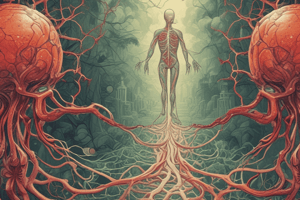Podcast
Questions and Answers
Blood is a special type of ______ tissue with fluid matrix.
Blood is a special type of ______ tissue with fluid matrix.
connective
The fluid matrix of blood is known as ______ and formed of water containing many dissolved proteins, hormones, minerals, enzymes, nutrients and gases.
The fluid matrix of blood is known as ______ and formed of water containing many dissolved proteins, hormones, minerals, enzymes, nutrients and gases.
plasma
Red blood corpuscles are also known as ______ or erythrocytes.
Red blood corpuscles are also known as ______ or erythrocytes.
RBCs
The main function of blood is to ______ oxygen, nutrients, minerals and hormones to tissues.
The main function of blood is to ______ oxygen, nutrients, minerals and hormones to tissues.
Blood films are histologically-examined using ______ Stain or Giemsa Stain.
Blood films are histologically-examined using ______ Stain or Giemsa Stain.
RBCs contain ______ % haemoglobin.
RBCs contain ______ % haemoglobin.
In ______ flow circulation, RBCs may adhere to one another as piles of coins.
In ______ flow circulation, RBCs may adhere to one another as piles of coins.
The glycocalyx includes ______ sites for ABO blood groups and Rhesus factor.
The glycocalyx includes ______ sites for ABO blood groups and Rhesus factor.
Old corpuscles are trapped by ______ of liver, spleen and bone marrow.
Old corpuscles are trapped by ______ of liver, spleen and bone marrow.
The normal shape of RBCs is maintained in plasma which is equivalent to osmotic pressure of ______% (NaCl) saline solution.
The normal shape of RBCs is maintained in plasma which is equivalent to osmotic pressure of ______% (NaCl) saline solution.
Flashcards
Blood type antigens
Blood type antigens
Sites on the glycocalyx responsible for ABO and Rhesus blood groups.
Blood's fluid matrix
Blood's fluid matrix
Plasma, a water-based solution containing dissolved proteins, hormones, minerals, enzymes, nutrients, and gases.
Red blood cells
Red blood cells
RBCs; cells carrying oxygen.
Blood's main function
Blood's main function
Signup and view all the flashcards
RBC structure (hemoglobin)
RBC structure (hemoglobin)
Signup and view all the flashcards
Osmotic Pressure in blood
Osmotic Pressure in blood
Signup and view all the flashcards
Blood film staining
Blood film staining
Signup and view all the flashcards
RBC clumping
RBC clumping
Signup and view all the flashcards
Macrophage role
Macrophage role
Signup and view all the flashcards
Connective tissue
Connective tissue
Signup and view all the flashcards
Study Notes
Blood and Its Components
- Blood is a special type of connective tissue with a fluid matrix that circulates within a closed system of blood vessels.
- It consists of 55% fluid matrix (plasma) and 45% formed elements (red blood cells, white blood cells, and platelets).
Plasma
- Plasma is the fluid matrix of blood, comprising 55% of its total volume.
- It is composed of water, dissolved proteins, hormones, minerals, enzymes, nutrients, and gases.
Formed Elements
- Red blood cells (RBCs or erythrocytes) make up the majority of suspended solids in blood plasma.
- White blood cells (WBCs or leucocytes) are another type of formed element.
- Platelets (thrombocytes) are the third type of formed element.
Red Blood Corpuscles (RBCs)
- RBCs are biconcave, non-nucleated, rounded discs.
- They have a diameter of 6-9 µm (average 7.5 µm) and a thickness of 2.2 µm at the periphery and 0.8 µm at the center.
- RBCs appear greenish yellow in color due to the natural color of hemoglobin, but appear red when stained.
- They contain 33% hemoglobin, 66% water, and 1% enzymes.
- RBCs are produced in bone marrow and have a lifespan of approximately 120 days.
Functions of RBCs
- RBCs transport oxygen, nutrients, and hormones to tissues.
- They remove carbon dioxide and metabolic wastes from tissues.
- They help regulate the internal environment and temperature of the body.
- They defend against microorganisms and foreign antigens.
Characteristics of RBCs
- RBCs have a Rouleaux appearance in slow circulation due to surface tension force.
- They have antigenic sites for ABO blood groups and Rhesus factor (Rh) on their glycocalyx.
- RBCs are osmotic fragile, meaning they can change shape in response to changes in osmotic pressure.
White Blood Cells (WBCs)
- WBCs will be discussed in detail later.
Platelets
- Platelets will be discussed in detail later.
Studying That Suits You
Use AI to generate personalized quizzes and flashcards to suit your learning preferences.




